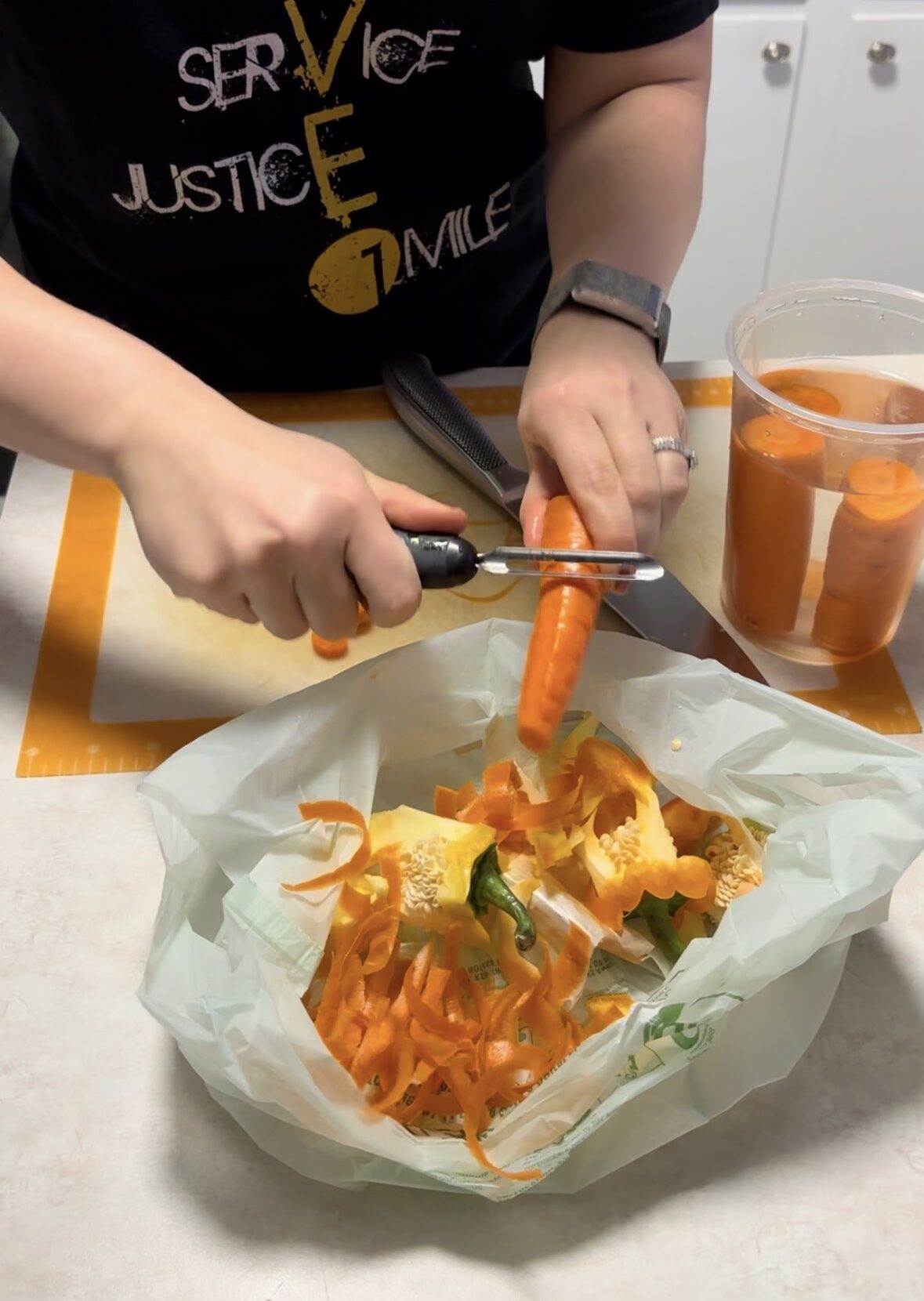What does organic really mean?
Not long ago I was traveling in Europe for work. We were talking about the obvious differences in food between Europe and the United States. My coworker made a comment that she didn’t “believe in” organic and natural labeled foods because they don’t mean anything. Although I primarily purchase organic foods, I understand that it might not be the right fit for everyone else. What I really hate to see is people making decisions without understanding what they are making a decision about.
Now the food industry definitely takes advantage of certain words. For instance, the word “natural” has no regulations behind it. Anyone can use that word and take advantage of people who don’t have the knowledge around food labels. Organic, on the other hand, has rigorous standards and is an actual certification that requires farmers, producers, distributors, re-packagers, etc. to keep up with the regulations and prove they are in compliance. The goal here is not to convince you to only eat organically grown products. The goal is to provide you with the information you need to decide if you want to eat primarily organic products.
History of the organic label
The Organic Foods Production Act (OFPA) was passed in 1990 in the United States. This act authorized the establishment of the National Organic Program (NOP). The NOP establishes the rules and regulations for how “organic” is defined in the US. The United States Department of Agriculture (USDA) manages the NOP. Prior to 1990, anyone could use the word “organic” as a marketing tactic without any group overseeing the methods used in production.
As part of the NOP, there is a National Organic Standards Board (NOSB) with fifteen expert volunteers. These volunteers are scientists, organic producers, environmental protectors, and more. They provide guidance to the USDA based on their expertise in their respective fields. Then the USDA makes decisions on new substances or new regulations for the NOP referencing their guidance. While the NOP is specific to the United States production, they also manage organic product imports. This ensures the quality of organic food products remains equivalent in the United States regardless of where production takes place.
Organic production requirements
First there are some general requirements regardless of what type of organic food you are producing.
- If you are producing or handling organic products intended for human consumption, you must maintain an “Organic System Plan”. This plan includes detailed explanations for how you intend to comply with regulations. It includes things like harvesting practices, the substances you will use to manage specific pests, how you maintain your records, how you will prevent contact with un-approved substances, among many others. You must receive approval on thus plan by a certifying agent who is an expert on the NOP regulations. Additionally this plan must be updated and approved by a certifying agent on an annual basis.
- Note that producers can receive approval for temporary deviations from the “Organic System Plan” due to natural disasters or to prevent loss of business. However, a deviation that includes a prohibited substance will not be approved.
- Ionizing radiation, sewage sludge, volatile synthetic solvents, and genetically modified crops (GMOs) are not permitted at all in organic production and processing methods.
- Organic farmers must manage the health of their soil to either maintain or improve soil quality. The reason soil health is important is because “crops more easily resist disease, survive drought, and tolerate insects when grown in good soil”. This means plant and animal by-products (compost and manure) must be managed appropriately to maintain and improve soil nutrients while preventing contamination.
- Organic producers must implement preventative measures to prevent pests, weeds, and diseases in plants and animals. If pests, weeds, or diseases make it through the preventative measures on the farm, physical measures like introducing a predatory species to manage the pests or “smothering” weeds by introducing mulch are common, allowable practices. The very last resort is using an approved pesticide. For animals, vaccinations are allowed and encouraged as preventative measures as well as ensuring proper sanitation to prevent diseases.
- One of the biggest questions: Do organic foods use pesticides? Contrary to popular belief, yes. Farmers must not use any synthetic substances, except for the permitted synthetic substances on the “allowable” list. Farmers can use most natural substances, except for natural substances on the prohibited substances list.
- Here is the allowable synthetic list for crops
- Here is the allowable synthetic list for livestock
- Here is the prohibited natural list for crops
- Here is the prohibited natural list for livestock
Additional requirements for produce
Here are some additional production requirements for organic produce specifically (fruits and vegetables).
- To label a product with the name “organic” in it, it must be harvested from an area where no prohibited substances were applied in the past three years.
- Organic seeds are a requirement. If organic seeds are not commercially available, this is an exception to the rule. However, even if the seeds are conventional, they still cannot be genetically modified or treated with any prohibited substances.
- Crop rotation is a common practice on conventional farms as well, but is a requirement for organic farms. This practice includes not planting the same crop in the same location year after year. Each type of crop grown requires different nutrients from the soil, so keeping the same crop in the same soil year after year can significantly deplete nutrient levels. Crop rotation supports soil health by diversifying nutrients in the soil. It can also help in controlling the insect population by interrupting their life cycles.

Additional requirements for animal products
I also want to briefly talk about specific production requirements for organic livestock.
- To sell livestock with the name “organic” in it, it must be treated under the farmer’s organic plan from the last third of gestation or hatching through the point of sale.
- Organic farmers must purchase organic livestock feed.
- Animals cannot receive drugs unless they are sick. This means growth hormone drugs are not allowable if the intention is to sell the animal as organic.
- A direct quote from the USDA: “The producer must establish appropriate housing, pasture conditions, and sanitation practices to minimize the occurrence and spread of diseases and parasites. Animals in an organic livestock operation must live under conditions which provide for exercise, freedom of movement, and reduction of stress appropriate to the species.” Why am I calling this quote out specifically? There can be a lot of confusion around the organic label in comparison to grass-fed or pasture-raised when it comes to livestock. The organic regulation leaves much up to the farmer’s interpretation. Grass-fed and pasture-raised are more stringent than the organic standard when it comes to livestock, but this deserves a deep dive on its own.

The organic label
Next, let’s talk about labeling requirements for organic foods. The National Organic Program (NOP) by the USDA also manages organic labeling requirements. This program regulates three terms: “100% organic”, “organic”, and “made with organic [list organic ingredients]”. I want to touch on all of these label categories individually, but first let’s cover some exceptions. Any producers or processors are exempt from these requirements and certifications if they have less than $5,000 of gross annual income from organic sales. Any food retail stores, including restaurants, are also exempt from these regulations.
The “100% organic” label is for a single item like a raw vegetable or fruit, or if every ingredient in the product is an organic ingredient. Even processing aids and other small additives must be organic to use this label.
The “organic” label is for products with greater than 95% of ingredients by weight being organic ingredients. The percentage excludes water and salt. If a non-organic ingredient is in the product recipe at less than 5%, the producer has to prove that the organic equivalent of that ingredient does not exist. This regulation lists the allowable agricultural ingredients that are not available as organic, and are allowable in products with the “organic” label at levels of less than 5% by weight. There are also non-agricultural additives allowable in products with the “organic” label. This regulation lists the allowable synthetic additives at levels of less than 5% by weight.
Lastly, the “made with organic [specific ingredient(s) or food group(s)]” label. This means the producer can decide what to list on the label, as long as the ingredient or food group is always organic for the product. This label must contain at least 70% organic ingredients by weight, excluding salt and water. Up to three organic ingredients or food groups may be listed on this label.
Trusting the organic standard
You may be curious how it’s possible to ensure compliance with all of these regulations. After all, the food production process is incredibly complex with a lot of steps to keep track of. There are a few ways the NOP monitors compliance to the organic product regulations. This includes ensuring the paper trail exists for transfer of organic foods from one company to another. It also includes the requirements of each farmer and producer keeping their “Organic System Plan” up to date and the recertification process each year.
Another way the NOP monitors compliance is through residue testing on organically labeled crops and products. Crops can be tested prior to harvesting or after harvesting. Any product that is sold or labeled as an organic product must be available for residue testing at any time. Residue testing helps prevent intentional deviations from the organic regulations. It also helps to identify when “drift” occurs unintentionally from nearby operations, improper segregation, or unavoidable environmental contamination on a specific piece of land. All testing must be performed at an accredited laboratory, using the most up-to-date methods and standards.
Each organic certifier must choose at least 5% of the organic operations they certify to submit for residue testing annually. If an un-approved pesticide is found at greater than 5% of the US EPA’s listed tolerance for that pesticide, the crop is considered “suspended” and can no longer be labeled as organic. Once a crop is suspended, no crops from that land may be labeled and sold as organic for the next three years. This includes products with any of the three labels (100% organic, organic, or made with organic…). While an investigation is ongoing for residue testing, information shared with the public is limited. However, residue testing results are available to the public for all crops, both organic and conventional, on the USDA website.
What does the organic standard mean to you?
Now that we know the details of what the organic regulations are, stay tuned for “Part 2” coming next week. We will talk about the effects of eating organic from a health and environmental perspective, and present the evidence in a way that will help you make a decision on what you prefer for you and your family.
SOURCES:
- https://www.ams.usda.gov/sites/default/files/media/NOP-Notice-ResidueTesting.pdf
- https://www.farmers.gov/your-business/organic
- https://www.ams.usda.gov/sites/default/files/media/Organic%20Practices%20Factsheet.pdf
- https://www.ams.usda.gov/sites/default/files/media/NOP%20Preamble%20Full%20Version.pdf
- https://www.ams.usda.gov/sites/default/files/media/Allowed-Prohibited%20Substances.pdf
- https://www.ecfr.gov/current/title-7/subtitle-B/chapter-I/subchapter-M/part-205/subpart-G/subject-group-ECFR0ebc5d139b750cd/section-205.601
- https://www.ecfr.gov/current/title-7/subtitle-B/chapter-I/subchapter-M/part-205/subpart-G/subject-group-ECFR0ebc5d139b750cd/section-205.602
- https://www.ecfr.gov/current/title-7/subtitle-B/chapter-I/subchapter-M/part-205/subpart-G/subject-group-ECFR0ebc5d139b750cd/section-205.603
- https://www.ecfr.gov/current/title-7/subtitle-B/chapter-I/subchapter-M/part-205/subpart-G/subject-group-ECFR0ebc5d139b750cd/section-205.604
- https://www.ecfr.gov/current/title-7/subtitle-B/chapter-I/subchapter-M/part-205/subpart-G/subject-group-ECFR0ebc5d139b750cd/section-205.605
- https://www.ecfr.gov/current/title-7/subtitle-B/chapter-I/subchapter-M/part-205/subpart-G/subject-group-ECFR0ebc5d139b750cd/section-205.606
- https://www.epa.gov/agriculture/organic-farming








Nieczęsto spotyka się teksty, które jednocześnie edukują, inspirują i oczarowują! Twój artykuł to nie tylko zbiór informacji, ale prawdziwa uczta dla umysłu. Twoje słowa otulają czytelnika niczym ciepły koc w chłodny wieczór, sprawiając, że chce się wracać tu raz po raz.
Trzeba mieć wytrwałość i wiarę we własne siły Twój portal jest tego przykładem. Trzeba wierzyć, że człowiek jest do czegos zdolny i osiągnać to za wszelka cenę!.